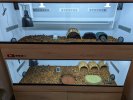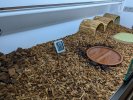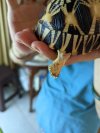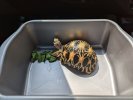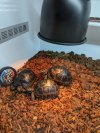Joefnd
New Member
Hi everyone,
I just returned from the vet due to a fungus infection growing on my 4 inch radiated tortoise. While I was there I was given a pep talk about the proper tortoise husbandry based on the vet's experience as she herself kept some for over 10 years.
She was completely against me doing a closed enclosure setup for them as it lacks the necessary air flow. Meanwhile, humidity and sufficient air flow conflicts with one another and you just can't have both, unless perhaps you have a dedicated tortoise room.
My question is how do you balance out 85% relative humidity and not have the tortoises be prone to fungal infection in a closed enclosure setup?
This incident hit me pretty hard as I have been maintaining this setup (according to the guide here) for over 6 months without a hiccup, and now this happens, to my favorite tortoise too.
In my eyes, I have maintained a very hygienic routine for them and there was just no explainable reason. My hands are always washed. Water dishes are cleaned and changed every day. The tortoises get their showers. Poop and left over food are picked up every day. New batches of fir bark is added when the amount in the cage has depleted. My temperatures and humidity are always within the acceptable ranges.
So, it's time for me to ask everyone if they had similar experiences and perhaps a solution. Hopefully it could point out a mistake on my part.
Thank you!
I just returned from the vet due to a fungus infection growing on my 4 inch radiated tortoise. While I was there I was given a pep talk about the proper tortoise husbandry based on the vet's experience as she herself kept some for over 10 years.
She was completely against me doing a closed enclosure setup for them as it lacks the necessary air flow. Meanwhile, humidity and sufficient air flow conflicts with one another and you just can't have both, unless perhaps you have a dedicated tortoise room.
My question is how do you balance out 85% relative humidity and not have the tortoises be prone to fungal infection in a closed enclosure setup?
This incident hit me pretty hard as I have been maintaining this setup (according to the guide here) for over 6 months without a hiccup, and now this happens, to my favorite tortoise too.
In my eyes, I have maintained a very hygienic routine for them and there was just no explainable reason. My hands are always washed. Water dishes are cleaned and changed every day. The tortoises get their showers. Poop and left over food are picked up every day. New batches of fir bark is added when the amount in the cage has depleted. My temperatures and humidity are always within the acceptable ranges.
So, it's time for me to ask everyone if they had similar experiences and perhaps a solution. Hopefully it could point out a mistake on my part.
Thank you!
